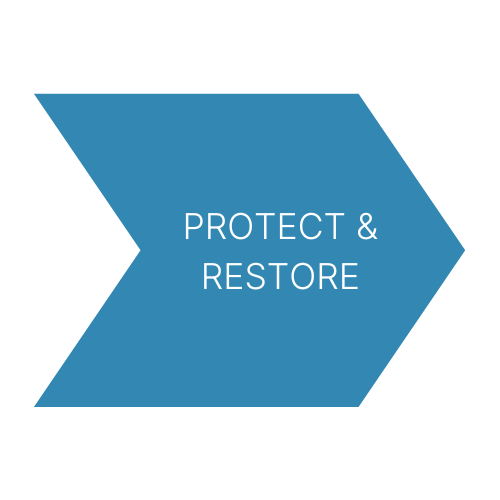Climate Action Plan
In 2021, 50 Degrees North became one of the founding signatories of the Glasgow Declaration, making a public commitment to reduce carbon emissions in accordance with UN goals to reduce the worst effects of climate change. In 2022, we released our Climate Action Plan, and since then we have been measuring, assessing, refining, and adjusting our goals year on year.
Our Commitment
“We declare our shared commitment to unite all stakeholders in transforming tourism to deliver effective climate action. We support the global commitment to halve emissions by 2030 and reach Net Zero as soon as possible before 2050. We will consistently align our actions with the latest scientific recommendations, so as to ensure our approach remains consistent with a rise of no more than 1.5°C above pre-industrial levels by 2100.”
Understanding carbon reduction in tourism can be complicated, so that is why we’ve created a simple 5-step Climate Action Plan to communicate what we are doing to address our own carbon footprint.
Our Climate Action Plan

In 2022, we partnered with ecollective – a specialist carbon consultancy – to measure our emissions in line with the GHG Protocol. This includes Scope 1, 2, and 3 emissions, covering HQ operations (such as staff meals, commuting, business travel) and all products and services booked through our company. Our results exclude anything not booked through us, such as additional meals or activities, or travel to/from the start of the trip.
Due to significant business growth – almost doubling passenger numbers over three years – we now report emissions on a per passenger per night basis, in addition to total emissions. This metric is used to track progress against our reduction goals.

The results

We break our carbon emissions into two distinct categories; the emissions that we generate through our HQ operations (such as running offices and staff business travel) and through the trips that we run. These results are based on 2024 data.
How are we tracking against our goals?

We have seen great success in lowering our emissions (29% decrease per passenger per night) but there is still work to be done. Based on our 2024 measurements we have adjusted our 2025 Climate Action Plan and here are our key reduction goals:
Trip Emissions

Coastal Voyages
The iconic journey along Norway’s renowned coastline remains central to our business and continues to be one of the primary reasons customers choose to travel with us. However, coastal voyages carry a significantly higher daily carbon footprint compared to land-based travel and therefore make up the bulk of our emissions. To meet our climate goals, it is crucial that we only partner with cruise operators whose emission reduction targets align with UN standards. Currently, we offer coastal cruises exclusively with Havila and Hurtigruten, both of which meet these criteria.

Photo: ©Oclin | Havila Kystruten
Accommodations
In 2024, we began collecting carbon footprint data from our accommodation partners and now have accurate data for approximately 60% of properties. Encouragingly, 98% of those surveyed met our climate reduction goals.
2025 Goal: We aim to collect accurate carbon emission data for 90% of priority accommodations, providing support to help them measure and report their emissions. This data will guide us in prioritizing partners with climate targets (and other sustainability credentials, such as environmental certifications or community support initiatives).

Photo: 29|2 Aurland
Transport: Cars
The Nordic countries are global leaders in electric vehicle (EV) adoption, with Norway at the forefront — nearly 90% of new car sales are electric. However, integrating EVs into the tourism sector presents distinct challenges: during peak travel months, self-drive tourists often encounter long queues at charging stations, which can disrupt holiday plans. Additionally, EV performance can be affected by cold weather and the rugged, steep terrain common in parts of the region.
2025 Goal: we will prioritise addressing these barriers to support the expansion of EV usage across our tours. We plan to collect accurate data from our car transfer suppliers so we are able to prioritize working with those that can offer EV. We also aim to adapt a selection of our self-drive itineraries to make it easier for travellers to choose EV.

Transport: Flights
Domestic
We have successfully reduced the number of domestic flights booked through 50 Degrees North by 59%. However, this figure does not include flights booked independently. Due to the remote nature of many destinations, especially in Lapland during winter, flying is sometimes the only practical option, making aviation a continued challenge for emission reduction.
2025 Goal: we aim to deepen our understanding of aviation-related emissions. We will research key factors influencing a flight’s carbon footprint, including aircraft age, use of Sustainable Aviation Fuel (SAF), flight distance, and routing. These insights will support more sustainable flight booking practices going forward.
International
While we do not include international flights in our packages, we recognise their significant impact, accounting for around 90% of a typical tour’s total carbon footprint. We encourage travellers to offset these emissions through verified carbon removal programmes, though emission avoidance remains the priority. To support this, in 2025 we developed a resource for travellers and agents on how to choose flights with a lower carbon footprint.

Transport: Rail and Minibus Travel
Due to the nature of our trips – such as remote adventures and winter holidays in Lapland – many itineraries are not easily accessible by public transport. This is reflected in our carbon footprint, with rail travel currently accounting for only 3% of our total emissions. Although rail currently makes up a small share of our bookings, it remains a scenic and sustainable way to experience the Nordics.
2025 Goal: we have introduced a dedicated Rail & Ferry section on our website, and we plan to launch new rail-based itineraries that take advantage of emerging routes.

Photo: Lari Laasjärvi
Customers travelling by minibus are part of our small group tours. These tours not only offer a rich and immersive travel experience, but also significantly reduce emissions on transport – by as much as 70-80% compared to an equivalent self-drive itinerary.
Goal: we aim to double the number of travellers on our small group tours within the next three years, supporting both our sustainability objectives and our commitment to more responsible travel.
HQ Emissions
By switching to renewable energy in all our leased offices and implementing detailed energy and waste reduction policies with staff, we have successfully reduced our Scope 1 and 2 emissions by 43%.
2025 Goal: we will build on this progress by increasing the proportion of meat-free meals in our weekly office catering and encouraging staff to adopt more sustainable working habits, such as car-free commuting and switching to renewable energy tariffs at home for those working remotely. We also aim to reduce emissions from our business travel by encouraging staff to book accommodations that use renewable energy, and to book the most carbon efficient flight possible using our guide.
Carbon Labels
In 2022, we became the first tour operator in Australia and across the Nordics to introduce Carbon Labels to a selection of our tours. By clearly labelling our tours with the carbon emissions they generate (known as a carbon label), it helps our customers to understand the impact of that tour and enables them to make sustainable decisions, and it shows us as a business where emission reductions can be made. Learn more on our carbon footprint page.
Protect & Restore

We are committed to protecting the natural environments we depend on and restoring those that have been degraded. Our approach goes beyond just reducing our emissions, we look across our business to identify where we can make a meaningful impact.
In 2024, we launched a number of initiatives that support biodiversity, such as our staff volunteering programme and our newly established Impact Fund through which we invested 850,000 NOK in 2024 in conservation projects and scientific research that actively seeks to protect and restore nature in the Nordics.
We also offset our emissions through funding climate action projects. In 2024, we partnered with South Pole, a founding member of the Nordic Carbon Removal Association, to offset our entire corporate carbon footprint by purchasing 2,585 tonnes of verified carbon credits. To ensure a comprehensive offsetting strategy, we support two main types of projects:
Avoidance-Based Projects: These prevent or reduce future greenhouse gas emissions. In 2024, we supported the Katingan Peatlands project in Indonesia (forest conservation) and the Hong Phong Solar project in Vietnam (renewable energy).
Carbon Removal Projects: These actively remove CO₂ from the atmosphere and store it. There is great potential for expanding the Carbon Removal industry in the Nordics, and we want to play our part. Therefore in 2024, we supported Bara Mineraler, a Swedish project that uses biochar to improve soil health and create durable carbon sinks in urban areas.
Collaborate

As part of our Climate Action efforts, we are committed to collaborating with stakeholders to raise awareness of climate change, and to go beyond awareness by empowering action.
2025 Goal: We will launch our first supplier-focused newsletter, which will include a survey enabling hotels to measure their carbon footprint, along with practical tips for reducing emissions. We will also engage with national tourism bodies to learn about their carbon reduction goals and policies, and explore how we can support and align with their efforts.
Evolve

2025 marks the third year since we released our initial Climate Action plan, and whilst we have seen great success in reducing our emissions in line with our goals, we are aware that now some of the easier wins have been achieved it may become harder to make reductions.
This new evolved plan has goals in place to start taking on these challenges, such as understanding how we can adopt electric vehicles into our itineraries, or reducing emissions associated with meals.
We’ve also evolved one of the key pillars of our action plan. What was once known as “Offset” is now “Protect & Restore.” While offsetting emissions remains a component of our strategy, it is no longer our primary focus. This change reflects a deeper, more holistic approach to regeneration. We are expanding our efforts to understand how every part of our business can contribute to restoring ecosystems, protecting biodiversity, and supporting resilient communities.
A more detailed look at our 2024 carbon measurement results and goals can be found in our Impact Report, available on our Sustainable Tourism page.